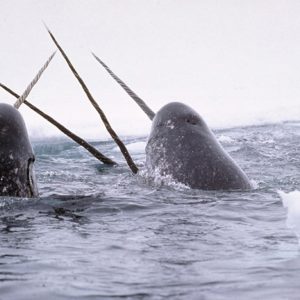Killer Whales
About the Killer Whale
One of the world’s largest animals, the Orca belongs to the Dolphin family (Delphinidae). Males can reach ten metres in length and 22,000 kilograms in weight. Females are smaller, but still considerable, at 8.5 metres long and 7,500 kilograms. Highly intelligent and distinctive for its black and white colouration, these magnificent creatures are also deadly. Poised at the top of the oceanic food chain, they are carnivores whose diet is often geographic and population specific. The Killer Whale’s menu could be fish heavy—such as salmon, herring, and tuna—or comprise larger marine life, such as seals, sea lions, penguins, sharks, and other whales and porpoises. Extremely social, Orcas live (and hunt) in matriarchal family pods typically comprising five to fifty whales and use echolocation to communicate. Killer Whales are distributed throughout the world, from the polar ice caps to the tropics near the Equator. In Canadian waters, there are noted populations in the northern Pacific along British Columbia, and, though less commonly, in the Atlantic and Arctic regions. In recent years, however, this has begun to change, as sea ice both recedes and occurs for shorter times each year.
Heading North and Staying There
One consequence of increasing melting and retreating ice and the growing unpredictability of ice formation schedules is the change in roaming patterns of Killer Whales, who now venture into far northern waters where they previously did not. Killer Whales typically avoid ice because of their high dorsal fins. With the loss of year-round sea ice in the Arctic, however, these cetaceans, once largely absent from the region, are now both spending more time there and going to areas that were formerly inaccessible due to permanent or seasonal ice cover. For example, Killer Whale sightings, once rare in Hudson Bay, have been reported not only during summer months but in winter as well.
The Orca Effect on the Arctic Ecosystem
Killer Whales in the Arctic are also disrupting the region’s fragile existing ecosystem. The disturbance of Narwhals is one such documented effect. Narwhals, nicknamed “sea unicorns” for the prominent tusks seen on males, are shy, wary whales who have been difficult to study due to the remoteness of their chosen habitats—two of three recognized populations of Narwhals live in Canadian Arctic waters, with the third occurring in eastern Greenland. A 2017 study demonstrated that the presence of Killer Whales drastically alters the behavior and distribution of Narwhals. Narwhals will move to and remain closer to the shore when Killer Whales are nearby, rightfully fearful and frazzled by the predator in the midst. Killer Whales, who hunt in packs, will try to push Narwhals into deeper waters and then encircle their panicked prey. By moving to shallower waters to flee Killer Whales, Narwhals become farther from the abundant stocks of fish that they eat. Additionally, staying closer to shore makes them more vulnerable to hunters. With Narwhals an important food source for the Inuit, the encroachment of Killer Whales into the Arctic also increases the competition for limited food sources. In addition to the Narwhal, Killer Whales in the Arctic are also preying on Beluga Whales and Bowhead Whales. With receding sea ice and continuing climate change, Killer Whales are poised to become a major Arctic predator to contend with. Today scientists continue to monitor Killer Whales and their impact on the Arctic marine environment. One tool that has proven particularly useful is questioning the local Inuit who directly observe these whales’ behaviors and interactions in the Arctic every day. Known as Traditional Ecological Knowledge (TEK), scientists combine these firsthand observations and cultural knowledge accrued over generations with their research to help form a clearer picture of Orcas in the Arctic. Acknowledgments: Fisheries and Oceans Canada, NOAA Fisheries, RCI, Science Daily




